american and european former slaves were brought back to africa mainly in what country?
Which Europeans Trafficked in Slaves?
The first 130 years the Portuguese dominated the transatlantic slave merchandise. After 1651 they fell into 2nd position backside the British who became the primary carriers of Africans to the New World, a position they continued to maintain until the end of the trade in the early on 19th century.
Based on data apropos 86% of all slaving vessels leaving for the New World, Eltis et al, estimate that the British, including British colonials, and the Portuguese account for seven out of ten transatlantic slaving voyages and carried nearly three quarters of all people embarking from Africa destined for slavery (Eltis et al 2001).
Volume of Transatlantic Slave Trade Departures past Carrier (in thousands) 1519–1800
Information Source: Eltis et al 2001
| Britain | France | Netherlands | Spain | United States and British Caribbean | Denmark | Portugal | |
| 1519–1600 | ii.0 | 264.one | |||||
| 1601–1650 | 23.0 | 41.0 | 439.5 | ||||
| 1651–1675 | 115.2 | v.ix | 64.8 | 0.2 | 53.vii | ||
| 1676–1700 | 243.3 | 34.1 | 56.i | 15.4 | 161.1 | ||
| Total % | 28.23% | ii.94% | xi.92% | one.15% | 55.75% |
| Britain | France | Netherlands | Espana | Us and British Caribbean | Denmark | Portugal | |
| 1701–1725 | 380.9 | 106.3 | 65.five | eleven.0 | xvi.vii | 378.3 | |
| 1726–1750 | 490.v | 253.nine | 109.2 | 44.5 | seven.6 | 405.6 | |
| 1751–1775 | 859.1 | 321.5 | 148.0 | 1.0 | 89.1 | 13.four | 472.nine |
| 1776–1800 | 741.3 | 419.5 | xl.viii | 8.6 | 54.3 | thirty.four | 626.2 |
| Total % | 40.55% | 18.06% | five.96% | 0.sixteen% | 3.26% | i.12% | xxx.89% |
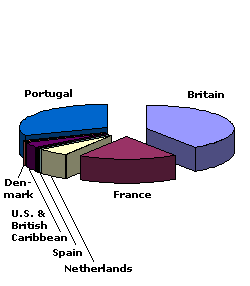
Volume of Transatlantic Slave Trade Departures past Carrier (in thousands) 1701–1800.
Data Source: Eltis et al 2001
France joined the traffic of slaves in 1624, Holland and Kingdom of denmark shortly followed. The Dutch wrested command of the transatlantic slave trade from the Portuguese in the 1630s, simply past the 1640s they faced increasing competition from French and British traders. England fought two wars with the Dutch in the 17th century to gain supremacy in the transatlantic slave trade. Three special English companies were formed, including the Royal African Company, to operate in the auction of slaves. They were given the exclusive rights to trade betwixt the Gold Coast and the British colonies in America. As the 17th century came to a close in 1698, English language merchants' protests led to the English language crown extending the right to trade in slaves more generally. Colonists in New England immediately began to engage in slave trafficking. Vessels left Boston, Massachusetts and Newport, Rhode Island laden with hogsheads of rum that were exchanged for people in Africa consequently enslaved in North American and Caribbean area colonies.
Beginning with the Spanish demand for slave labor, a need that continued and expanded in the other colonies and the United States even subsequently abolition of the trade in 1807, the Transatlantic Slave Trade brought betwixt 9.6 to 11 meg Africans to the New Earth (Curtin 1969; Donnan [1930]2002; Eltis et. al 2001; Hall 1992). Greater numbers of people were sold into slavery from some regions every bit compared to other regions. Some European nations transported more Africans than others and some regions in the New Earth received more Africans from certain regions than others. The British and Portuguese account for vii out of every ten transatlantic slaving voyages and carried nearly 3 quarters of all people embarking from Africa destined for slavery (Eltis et al 2001).
Where did enslaved Africans come from?
In the starting time 150 years of the trade, West Key Africa supplied nine out of ten African people destined for a life of slavery in the Americas. Except for a fifty-yr period between 1676 and 1725, Due west Central Africa sent more than slaves to the Americas than whatsoever other region. In the first century of trading over 900,000 (52%) of all Africans leaving the continent came from Due west Key Africa.
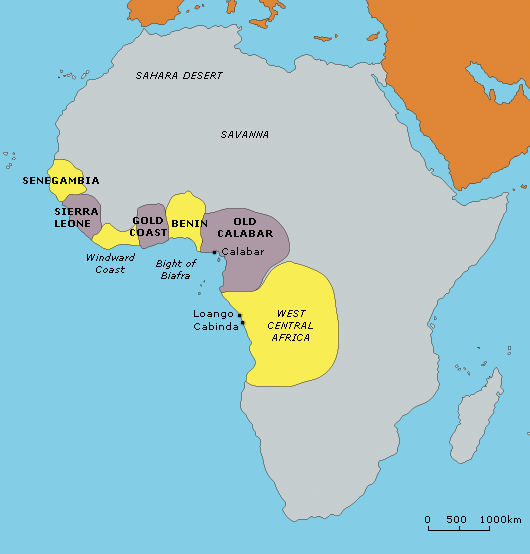
Map of embarkation areas in Due west and West Central Africa.
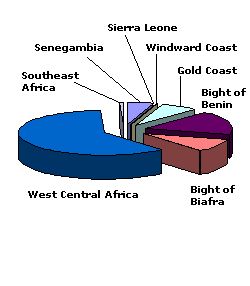
Book of Transatlantic Slave Trade by Region of Embarkation (in thousands) 1519–1700.
Data Source: Eltis et al 2001
The majority of all people enslaved in the New World came from West Central Africa. Earlier 1519, all Africans carried into the Atlantic disembarked at Onetime World ports, mainly Europe and the offshore Atlantic islands. From 1493, the year of Columbus's second voyage, some of these Africans or their progeny entered the New Earth. The first vessel conveying slaves that sailed directly between Africa and the Americas appears to have arrived in Puerto Rico in 1519 (Eltis et al).
The African slave trade in the easily of the Portuguese, was more than fifty years old when the 16th century began. The Portuguese were to hold a monopoly on the merchandise until the century ended. Sixteenth century Africans enslaved past the Portuguese came from the Kongo, one of the largest African states, and its tributaries. The "Mani Kongo," or king of the Kongo, ruled a geographic area of 60,000 square miles that was inhabited by an estimated two.5 meg people.
Book of Transatlantic Slave Trade by Region of Embarkation (in thousands) 1519–1800
Data Source: Eltis et al 2001
| Sene-the gambia | Sierra Leone | Wind-ward Coast | Gold Coast | Bight of Benin | Bight of Biafra | West Central Africa | Southeast Africa | |
| 1519–1600 | ten.7 | 2.0 | 10.vii | 10.7 | 10.vii | 221.2 | ||
| 1601–1700 | 60.6 | 3.ix | 0.8 | 90.9 | 247.8 | 135.6 | 698.eight | xiv.one |
| Total % | 4.seventy% | 0.39% | 0.05% | half-dozen.69% | 17.02% | 9.63% | 60.59% | 0.93% |
| Sene-gambia | Sierra Leone | Air current-ward Coast | Golden Coast | Bight of Benin | Bight of Biafra | Westward Central Africa | Southeast Africa | |
| 1701–1725 | 39.9 | 7.ane | 4.2 | 181.vii | 408.iii | 45.viii | 257.2 | xiv.4 |
| 1726–1750 | 69.9 | 10.five | 14.3 | 186.three | 306.1 | 166.0 | 552.viii | 5.4 |
| 1751–1775 | 130.4 | 96.9 | 105.1 | 263.9 | 250.five | 340.ane | 714.9 | three.3 |
| 1776–1800 | 72.4 | 106.0 | 19.5 | 240.7 | 264.6 | 360.4 | 816.2 | 41.2 |
| Full % | 5.13% | 3.62% | ii.35% | 14.31% | 20.17% | fourteen.97% | 38.41% | 1.05% |
The Kings of the Kongo and the European merchants were both aware that human labor was one of the greatest productive resources of the southern savanna. In that location was no such thing equally a "course" of slaves in Kongo gild. Even so, in that location were many people acting in a transitory status as servile subjects:
"…These people were of foreign origin, people who had been outlawed for criminal acts, people who had lost the protection of their kinfolk; or go irredeemably indebted to others. They differed from slaves in European ownership in that they were likely to be reabsorbed into society. Families and clans probably welcomed foreign accessions to their numbers. …Women were particularly easy to integrate, but even male person strangers did non remain the 'slaves' of society for very long (Birmingham 1981:32)."
From the 16th through the early 20th century slaves in the Kongo had rights to off-white treatment, to receive a share of their earnings, and to buy freedom. Their children did non necessarily become slaves. Neat and famous men could and did ascension from the ranks of Kongo slaves. This understanding of what it means to be a slave may account for the initial willingness of Kongo royalty to engage in slave trading. Later, the Kings had little option (Brown 1987).
The earliest Cardinal African slaves were the external captives of the Bakongo. Attempts to confine slaving to external captives failed and shortly slaves from within Kongo social club were existence sold. Many were captured warriors from the 1569 Jaga Wars. By the mid 16th century, after the Portuguese established Angola colony in Mbundu territory, the tribute formerly passed upwardly to the King was paid to a Portuguese army officer rather than to the traditional chief. The army officers required that tribute be paid in the form of slaves. By the finish of the 16th century, 10,000 slaves a year were beingness exported from Luanda, the slave catchment area of Angola (Birmingham 1981:32–37).
By the middle of the 18th century, people from the Bight of Biafra were likewise highly represented among those Africans enslaved in the Americas (Walsh 2001). Randy Sparks provides a detailed business relationship, based upon master source documents virtually how 18th century Africans and Europeans conducted the slave trade. His clarification is unusual because some of the chief sources were written by Africans (Sparks 2002).
Where did enslaved Africans disembark?
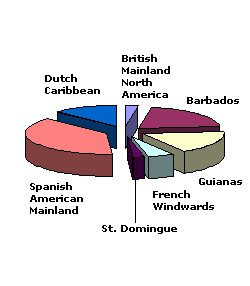
Volume of Transatlantic Slave Trade by Region of Disembarkation (in thousands) 1701–1800.
Although much has been fabricated of the thought that the colonials had preferences for people from sure ethnic groups inside Africa and that enslaved people were randomly distributed, Eltis et al suggest otherwise. Brazil and British American ports were the points of disembarkation for most Africans. On a whole, over the 300 years of the Transatlantic slave trade, 29 per cent of all Africans arriving in the New World disembarked at British American ports, 41 per cent disembarked in Brazil.
Perhaps five–10 percentage of all Africans who arrived in the Americas quickly moved to other parts of the Americas, as office of an intra-American slave trade. Nearly Africans arriving in Castilian America came from an intermediary point of disembarkation rather than directly from Africa. Exactly how many cannot be deduced from the data analyzed by Eltis et al., withal they estimate the mainland Spanish colonies may have received one-half of their arrivals through intra-American slave merchandise and the mainland British colonies fewer than 5 percentage in this manner.
Volume of Transatlantic Slave Trade past Region of Disembarkation (in thousands) 1519–1800
Data Source: Eltis et al 2001
| British Mainland N America | Barbados | Guianas | French Wind-wards | St. Exercise-mingue | Castilian American Mainland | Dutch Caribbean area | |
| 1519–1600 | 151.6 | ||||||
| 1601–1650 | 1.4 | 25.4 | 2.0 | 187.7 | 2.0 | ||
| 1651–1675 | 0.9 | 63.2 | 8.2 | 6.5 | 38.8 | ||
| 1676–1700 | nine.8 | 82.3 | 27.8 | sixteen.6 | iv.8 | vii.0 | 26.0 |
| Full % | 1.90% | xvi.93% | fourteen.31% | four.21% | ane.78% | 54.45% | 6.42% |
| British Mainland North America | Barbados | Guianas | French Air current-wards | St. Do-mingue | Spanish American Mainland | Dutch Caribbean area | |
| 1701–1725 | 37.iv | 91.8 | 24.4 | 30.ane | 44.5 | 30.0 | 30.5 |
| 1726–1750 | 96.8 | 73.6 | 83.half-dozen | 66.8 | 144.9 | 12.vii | 10.ii |
| 1751–1775 | 116.9 | 120.9 | 111.9 | 63.7 | 247.five | 5.0 | fifteen.3 |
| 1776–1800 | 24.4 | 28.five | 71.2 | 41.two | 345.8 | 10.2 | 6.9 |
| Full % | 13.92% | xv.90% | fourteen.70% | 10.19% | 39.53% | 2.92% | 2.83% |
In about regions, during the colonial period when Africans were adapting their cultural patterns to the new environment, they like other people coming to America before 1750 were less probable to exist of diverse origins (Eltis et al 2001; Walsh 2001). Nevertheless, over fourth dimension people from different regions of Africa arrived, which resulted in the mixing of peoples. Based upon these findings equally well as recent archeology of African American sites from the colonial period, historical interpretations of colonial life amidst Africans demand to revisit notions of Africans being unable to communicate with one another, or being randomly distributed in the colonies.
In 1763 when France ceded Louisiana to the Spanish there were 46,000 African people enslaved at that place as compared to 36,500 free persons, mostly white (Hall: 1992:29–55). Most of these Africans came from points north of the Windward Declension and many had originally disembarked in St. Domingue (Hall, 1992). As loftier equally these population data seem, the bulk of all Africans imported in North America during the colonial period were enslaved in the Chesapeake and Low Land regions. Read more about people enslaved in French America.
Chesapeake Colonies
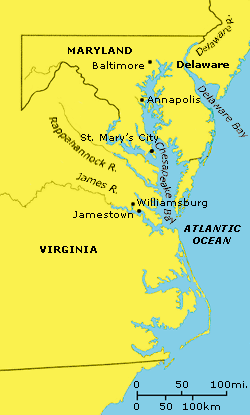
Chesapeake Colonies.
Jamestown, founded in 1607, and the first English settlement to receive Africans as slaves in 1619, is located on the James River, a tributary of the Chesapeake Bay. The colony imported very few Africans betwixt 1619 and 1660. Most who came to the region were from West Key Africa coming by way of Dutch slave traders.
The people who founded the colony have been called "gentlemen adventurers," meaning they had little feel, expertise or inclination to perform the labor intensive tasks associated with establishing settlements, growing subsistence crops or developing bolt for export. In curt they needed labor to develop the economic potential of the colony. They showtime used indentured white laborers. Issues with indentured servants led to a gradual growth of African slavery that began during the second half of the 17th century.
The primeval English settlers in the Chesapeake region relied heavily on indentured persons for labor. The Dutch brought the first Africans to the Virginia colony in 1607. These Africans and others that followed helped to build the colony and cultivate tobacco.
Tobacco was the 17th century North American "Gold." In the 17th century tobacco cultivation in the Chesapeake depended generally on white labor, small farm owners and indentured servants, but tobacco demanded daily attending. Ii or three acres were the virtually a farmer could tend himself. To increase production beyond this subsistence level—to better himself economically—the farmer needed boosted labor. Virginia looked to England and Africa for that labor supply, English language indentured labor and enslaved Africans. The 18th century success of large scale tobacco production in the Chesapeake was dependent on enslaved African labor and, after 1740, on 2nd and third generation African progeny (Kulikoff 1986:396). In 1629,Virginia produced 1.5 million pounds of tobacco. In 1775, a little less than 150 years later, Virginia and Maryland produced 100 one thousand thousand pounds of tobacco. Every bit Morgan points out, the colonial economy in Virginia, and ane might add the Chesapeake region in general, was congenital on the backs of enslaved African labor, without which information technology was an economy without a labor supply (Morgan 1998:146 Walsh PP 194–195).
The increased importation of Africans into Virginia was a crucial gene in the early 18th century emergence of a relatively stable political and economical structure in the colony in which the largest landowners increasingly relied upon slave labor. The landowners also came to monopolize economic, political, and social leadership of the colony. They passed laws that provided fewer restrictions upon white laborers during their servitude and opportunities for them to acquire land-ownership in one case their terms were up. These concessions guaranteed their acquiescence to the social and political domination past the landed gentry (Walsh 2001).
Analysis of slave trade data from three sources, the Westward.Eastward. B. DuBois Plant dataset, Virginia Slave Trade Statistics and Maryland Naval Office shipping records, along with archeological testify suggest a more patterned trade occurred in the Chesapeake than reported in early histories of the region (Walsh:2001:14–15). Throughout the 18th century, approximately three quarters of the Africans arriving in the Upper Chesapeake besides as in the region around the lower James River came from the upper parts of the West African coast, from Senagambia on the north to the Windward and Gilt Coasts, an expanse which included present day Senegal downwardly along the coast catastrophe in the area of present day Republic of ghana (Walsh 2001:31). About Africans arrived in the lower James area past manner of the intra-Atlantic coastal slave trade from the Westward Indies, which probably accounts for ethnic variety of Africans enslaved there.
Nearly three quarters of the Africans disembarking in the lower Chesapeake area (York and Upper James Bowl) came from more southerly parts of Africa, from the Bight of Biafra (present twenty-four hour period eastern Nigeria) and West Primal Africa (then called Kongo and Republic of angola). The concentration of Virginia's enslaved people who had common cultural characteristics was perpetuated by the inheritance practices of the Virginia gentry, peculiarly those in York and Rappahannock districts. The resulting ethnic concentration of enslaved communities originally from W Central Africa and the Bight of Biafra in these regions facilitated continuity of family unit and kinship networks, settlement patterns, and intergenerational transmission of African customs and languages.
Before historians oft suggested that planters' preferences for slaves from item African regions influenced the ethnic composition of the slaves in the Chesapeake region. However, the analyses of the W.E. B. DuBois Institute Projection indicates other factors resulted in Virginia planters' frequent buy of laborers originating in the Bight of Biafra and Angola, people for whom, one author comments "no Chesapeake planter is known to take expressed a preference" (Walsh 2001:30–21). These factors included the marketplace that British slave traders judged to be the virtually lucrative outlet, their involvement in the planters' exports, e.g. tobacco, which slaves were being offered, and even the tonnage of the ships on which a group of Africans were captive. The merchants took the ships with the greatest number of Africans to the all-time markets first (Curtin 1969). Learn more than about the African origins of people enslaved in colonial Chesapeake.
Low State Region
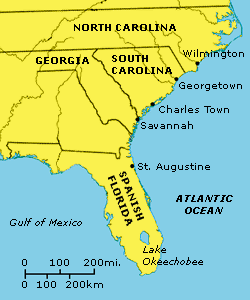
Low Country Colonies.
South Carolina was settled in 1670 more often than not by colonists from Barbados. John Colleton, a Barbadian planter gained a regal lease to the American region just below Virginia and he proposed, would extend to a southern purlieus well below the Spanish settlement of St. Augustine. (See Map Depression State) According to Peter Woods, Colleton and seven other British gentlemen aimed to capitalize on the internal migrations underway between American colonies and plant their colony past relocating experienced settlers from Barbados to the mainland in a region with sub-tropical climate. To promote their venture, the Colleton grouping promised prospective settlers land, that by that fourth dimension was in short supply in Barbados, in proportion to the number of people a head of household brought with them, including and especially "Negroes."
The Colleton group advertisement reached out to landless people similar indentured servants completing their terms of indenture. As a result, people migrated to South Carolina not merely from Barbados, but also from the Bahamas, Jamaica, Bermuda, England, New England, New York, New Bailiwick of jersey and the entire Chesapeake region. Each brought as many other European people, who were in short supply, with them as they could muster and as many Africans, who were in large supply, as they owned or could buy. As a result of these measures, from the very earliest years of the colony, 20 to 30 percentage of the settlers were Africans of diverse ethnic origins but with some mutual cultural characteristics from "seasoning" or nativity in the W Indies. However, inside fifty years, South Carolina had to import Africans directly from the continent in gild to maintain the needed supply of labor. The economic transformation of early modern Europe between 1650 and 1750 both assured a demand for rice in the West and allowed the Depression Country to become the source meeting that demand (Coclanis 1985:253).
Based upon Due south Carolina records of the ethnic origins of slaves, Curtin estimated that 39.65 percent of slaves imported to South Carolina between 1733 and 1807 were 'congos' or Angolas. Africans from Senegambia (19.5%), the Windward Coast (16.3%) and the Gold Coast (13.3%) were also imported into South Carolina during the latter time period. Wood also analyzed data regarding the origin of ships delivering Africans to Charlestown, South Carolina from March 1735 – March 1740. He found 70 percent of Africans arriving came on ships from Angola (Curtin 1969; Woods 1974:340–341). In sum, past the middle of the 18th century, the bulk of the large population of Africans living in South Carolina had roots in Due west Cardinal African culture or was influenced by information technology.
Middle Colonies
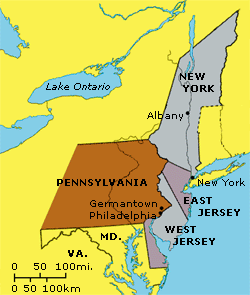
Middle Colonies.
Betwixt 1624 and 1664, the Dutch established colonies n of the Chesapeake along the rivers now known as the Delaware and Hudson Rivers, Numbering merely a few thousand, they settled primarily in the lowlands that somewhen would become the British colonies of Delaware, New Jersey, and New York. Parts of what became Pennsylvania were too in the region settled past the Dutch.
The settlers of New Netherlands (as the areas became known) represented a range of European backgrounds. They had been recruited by the Due west India Visitor and by individual company Directors from all the provinces of the Dutch Republic, from the surrounding low countries, from Norway, Kingdom of denmark, and Sweden, as well as from the German states. Africans came with them, offset with Henry Hudson'southward exploration of the area fifteen years earlier settlers arrived.
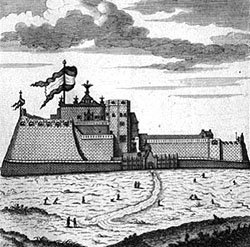
Elmina Castle, Gilded Coast 1704.
The first recorded Dutch trader sold twenty Africans to the colony of Virginia in North America in 1619. Between 1620 and 1655, the Dutch fought with Portugal and won command of sugar plantations in Brazil as well as of many of the Portuguese slave depots on the West African coast, including São Jorge da Mina a slave factory, renamed Elmina past the Dutch. Not realizing the expected traffic in human beings that they had anticipated in Elmina, the Dutch seized the island slave depot of São Tomé off the coast of Angola. Although they ultimately lost New Netherlands to the British and their holdings in Brazil to the Portuguese, the Dutch continued transporting Africans to Curacou which emerged equally a slave market open to colonies in the whole Caribbean as well equally those on the British North American mainland.
As noted in the Carrier and Embarkation tables and graphs, between 1601–1700, some 90,000 Africans embarked from the Gold Coast and 698,000 from Angola. The Netherlands were carriers for 40 odd thousands of Africans in the showtime half of the century and threescore,000 plus in the latter half. About of these people were from the Dutch slave depots in Angola (McManus 1973:7–9).
Subsequently the British took over New Netherlands, they renamed the regions of the colony along the Hudson, and along the Delaware, New York, West Bailiwick of jersey and E Jersey, respectively. The area of settlement beneath the mouth Delaware River, formerly New Sweden was renamed Delaware. In 1664, the Delaware settlers contracted the West Republic of india Company "to transport hither a lot of Negroes for agricultural purposes." The same year the British sought to increase the enslaved population in New Bailiwick of jersey past offer colonists 60 acres of land per "slave" imported. Even with the enticement of land and a port for slave ships at Perth Amboy, New Jersey, the enslaved population in New Jersey remained depression. Pennsylvania, populated by a multifariousness of Protestant sects fleeing from religious persecution, also had a low enslaved population that grew very slowly until effectually 1730. By 1754 in that location were nearly 11,000 Africans and native born African progeny in all of Pennsylvania. While in New York there were 13,000 adult "Negroes" in 1756, the largest group of enslaved workers in the northern colonies (McManus 1973:xiv–16).
New England Colonies
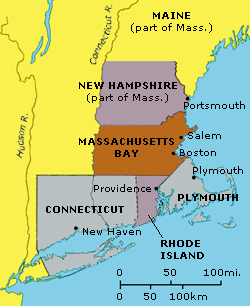
New England Colonies.
Justifying slavery on economic, spiritual and legal grounds, to many New England Puritans, slavery represented inexpensive labor needed to establish their colony and an opportunity to convert African and Amerindian "heathens" to Christianity. Pequot women and girls were enslaved by the Puritans post-obit the Massachusetts and Connecticut militias and Pequot War in 1637. The Puritans transported most of the men and boys on the ship Want to the West Indies to be exchanged for African "slaves". The Desire returned in 1638, having traded Pequots for Africans, loaded with "common salt, cotton wool, tobacco and Negroes." Over the adjacent half dozen years the New England Puritans initiated direct merchandise for "slaves" in Africa (Mintz due north.d.:9)"
New England colonists were more than involved in slave merchandise than in holding slaves for labor. Narragansett, Rhode Island, was an exception, where forces of about fifty slaves grew tobacco. The first Usa Census in 1790 found Rhode Island to be second only to Connecticut in the size of its slave labor force in the New England states.
Slave traders gear up canvas from Newport, Rhode Island. Virtually grand slave trading voyages left Rhode Island ports and made upward well-nigh half of all slave vessels from the North American mainland to Africa. Portsmouth, New Hampshire was too a slave trading port but had a pocket-size enslaved population of 674 in 1773 that had decreased to 157 by 1790.
With the exception of New Bailiwick of jersey, the Revolutionary Period was accompanied by the enactment of laws to complimentary enslaved Africans (See Laws section below). The Africans enslaved in the north mostly came by way of the Caribbean, with Philadelphia, Perth Amboy, New York and New England as the last ports of call in the triangular Transatlantic Slave Merchandise or the Atlantic inter-coastal trade between Charleston and Portsmouth (Horton and Horton 1997).
French Colonies
By 1719, the French began to import Africans slaves into Louisiana from the Senegal concession of the Company of the West Indies. Most of the people living in the Senegambia area, with the exception of the Bambara, were converted to Islam nether the Republic of mali and so Songhai Empires. Since Islamic law prohibited Muslim enslavement of other Muslims, the Bambara who resisted religious conversion were highly represented amongst those sold into slavery. Dr. Gwendolyn Hall documents that Africans of Bambara origins predominated amidst those enslaved in French Louisiana during the American colonial period. The common Mande civilisation that the Bambara people brought to French Louisiana would afterwards influence evolution of the Creole culture in the colony (Hall 1992:29–55). Some of these influences that keep to exist evident among the people of Louisiana, specially African Americans, are addressed in Cultural Heritage, Office II of this unit.
Summary of Transatlantic Slave Merchandise
Britain and Portugal dominated the slave trade. Before 1650, the Portuguese transported more than 95 pct of what appear past afterwards standards to be a small flow of people. Betwixt 1660 and 1807, when the slave trade was at its acme, the British and their dependencies carried every 2nd slave that arrived in the Americas, a authorisation that would no doubt have continued but for the politically inspired decision to abolish the merchandise.
Slave Traffic from Africa: 1451–1870
- 1451–1600: commencement (i/iv million)
- 1601–1700: growing (one.3 million)
- 1701–1811: peaking (6 1000000)
- 1811–1870: declining (2 million)
(McCaa 1997)
The all-time estimates propose that between 1451 and 1870 when the transatlantic slave trade concluded, over 9 million people were transported from Africa to be enslaved in the New World (McCaa 1997).
On the African coast, West Central Africa was an even more important source of people for the New Earth slave markets than recent literature credits. For every region outside Angola there was a pattern of a marked rise in slave departures that occurred in sequence, followed by a plateau of departures that connected until a rather sudden terminate to the traffic. Still for Angola, the blueprint was unlike. After the swing away from export of Africans from Angola, a render to exporting people from Republic of angola occurred.
In the Americas, sugar was the driving force in the slave merchandise, though gold and silver were of import in the earliest phase of the traffic. Java would later assumed the role of sugar in the final phase. American cotton would non develop equally an export until after the Us abolished slave trade.
Perhaps the most important conclusion of recent history on the subject of transatlantic links is that "the moving picture of African coerced migrants arriving mainly in a mix of peoples—frequently on the same vessel—needs revising." Like the free migrant and indentured servant trades, systematic geographic patterns existed. Eltis suggests, " Scholars should at present turn to exploring what these hateful both for Africa and for African influences in the shaping of the New Globe… (Eltis et al 2001)."
Source: https://www.nps.gov/ethnography/aah/aaheritage/histcontextsd.htm
0 Response to "american and european former slaves were brought back to africa mainly in what country?"
Post a Comment